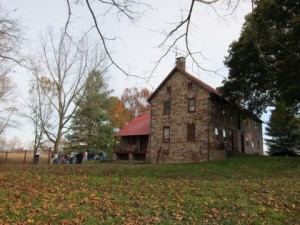Modern treasure hunt
 Just a few miles south of Messiah College, a 244-year-old farm is the site of an archaeological dig involving Messiah students, young participants in the Oakes Museum Curator Club, and older adults from nearby Messiah Village’s Pathways Institute for Lifelong Learning. The treasures from this effort aren’t simply the artifacts buried beneath the ground. The great value, according to the dig directors, is in collaboratively exploring regional history, answering real research questions and adopting keen problem solving skills.
Just a few miles south of Messiah College, a 244-year-old farm is the site of an archaeological dig involving Messiah students, young participants in the Oakes Museum Curator Club, and older adults from nearby Messiah Village’s Pathways Institute for Lifelong Learning. The treasures from this effort aren’t simply the artifacts buried beneath the ground. The great value, according to the dig directors, is in collaboratively exploring regional history, answering real research questions and adopting keen problem solving skills.
David Pettegrew, a professor in the Department of History, and Ken Mark, director of the Oakes Museum of Natural History, are overseeing the dig at the Stouffer Farm, a York County property dating back to 1767. The dig has been underway since fall 2010.
Students in Pettegrew’s historical archaeology course were the first to excavate the site. Having an opportunity to dig at a nearby location, rather than overseas, is quite unusual, Pettegrew explains. Student Katie Garland `12 adds, “I am sure that Dr. Pettegrew could work through this site by himself much more quickly if he did not have to teach all of us about the process of archaeology, but he is happy to pass on his expertise and help others learn.”
Pettegrew helps his students understand how to examine a property through an archaeological lens with the greater goal of unearthing artifacts to reveal other details that could help place the farm and the Stouffer family within their regional context. It is still unknown what led Abraham Stouffer and his family to settle on this land just a few miles south of Dillsburg, and even all the suspected uses of the property aren’t entirely confirmed. For example, Pettegrew, Mark and the students are trying to locate a grist and saw mill once located on the site and they’re searching for additional links between the farm and a nearby cemetery where several Stouffers are buried. Questions about the site are plenty. “We’ve only just scratched the surface,” Pettegrew explains.
The process of excavating the area involves establishing an invisible grid over the area to be dug. Then excavation happens in small square units following the natural and cultural layers (the “strata”). All earth removed from the unit is carefully sifted for material culture. Artifacts discovered in the unit are left in place until completely uncovered. Once uncovered and removed from the site, the artifacts are taken to the Oakes Museum for cleaning, description, analysis, identification and, eventually, display.
So far those digging at the site have found old shoes, ceramics from the late 19th and early 20th century, nails, coal, pieces of metal and animal bones, among others. Excavation of the interior of an on-site outbuilding uncovered garbage pits. That might sound like an unpleasant find but the pits and their contents provide helpful clues as to when that particular building had fallen out of use.
Each day of digging is a bit of an adventure. Garland recalls digging with elementary school children during a Curator Club dig one Saturday when she helped the young students pull out a huge iron chain. “I enjoy talking to the kids about the process and watching them make connections between the artifacts and the history of the site,” Garland adds.
The Stouffer Farm dig has created some great opportunities for collaboration, according to Pettegrew and Mark. Messiah students taking Jeff Erikson’s GIS class are helping to digitize maps. An art history student is currently analyzing the pottery. Folks doing genealogical research in the area are connecting with the project and adding their own findings to the collected body of research. Visitors to the Oakes Museum enjoy seeing what has been uncovered, and the current owner of the farm, Diane Phillips, is thrilled to know more about her property.
You can follow the dig via photos and blog posts at Stouffer Farm.




